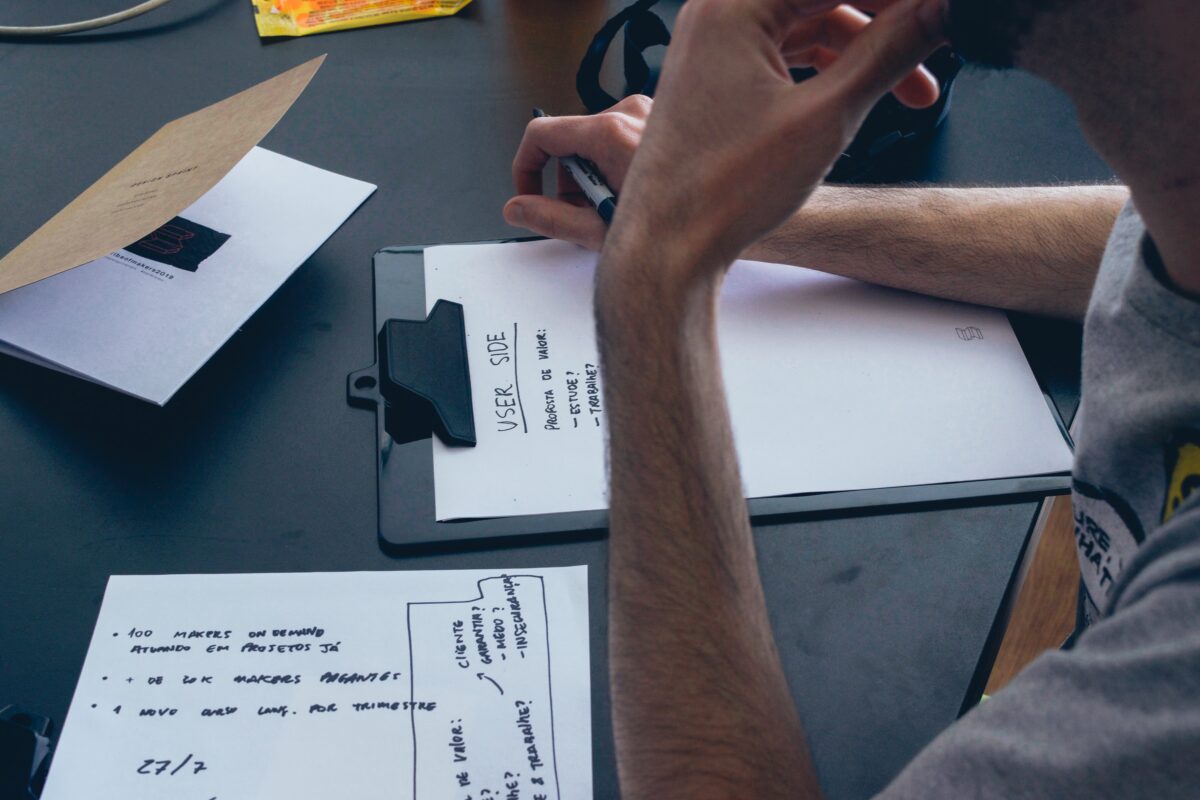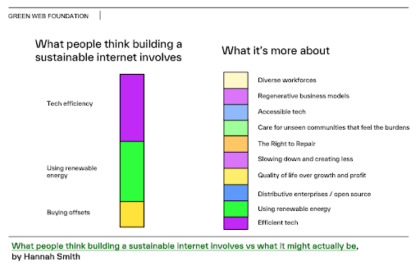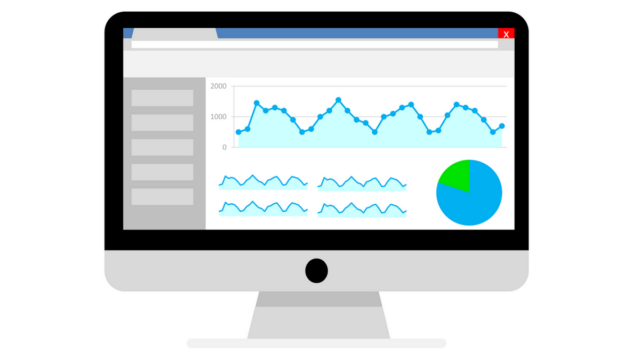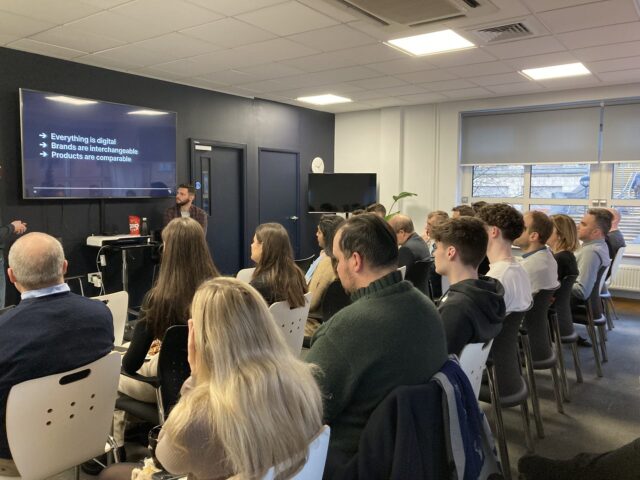Senior UX Designer, Rachel Wong, attended UX London this summer to hear from experts in the industry about everything from building better design processes and digital sustainability, to what the UX community can do to help create a better world.
She shared with us everything she’s learnt, covering the following topics:
- Building sustainable, inclusive design processes
- Digital sustainability
- Busting design system myths
- Women-centric design
- Experience beyond screens
- What if people weren’t the product?
- Choosing empathy
Building design processes
Vimla Appadoo, Director of Culture Design at Honey Badger, kicked off UX London 2023 with an honest, vulnerable sharing session about how she has implemented more people-first design processes in her organisations, that she believes to be essential for sustainable product growth, and provided some actionable recommendations for leaders to do the same in theirs. While not all of us are leaders, Vimla shared reflection activities that we can do as individuals, and also encouraged employees at any level to raise their voice in proposing some of these ideas internally.
Takeaways:
1. Putting people first: taking a culture-first approach to building design processes means putting people first. In application, this means to find commonalities and differences amongst team members to inform behavioural guidelines.
2. It starts with you: culture creation starts with the individual. All of us can take part in a self-reflection exercise to identify what are our “core” vs “flex” values… or in other words, what makes you, you? It’s important to then share these values with team members and increase cultural awareness.
3. Move from values to principles: by first understanding team values, these become behaviours, and eventually principles that can be embedded into an organisation.
4. Culture add > culture fit: the search for “culture fit” during hiring is not enough. This approach limits the organisation to the same points of view and the same ways of thinking. Instead, we can move toward the idea of culture add, where there is added difference (that goes beyond surface level of token diversity).
5. Review internal hiring processes: have you ever thought about where you’re promoting roles? Where it’s promoted will affect who’s in the pool of candidates. Always aim for transparency on how your organisation hires, and make it an active effort to collect numbers and datas about the types of people you’re hiring.
6. Create safe spaces: an environment that is psychologically safe will help in receiving honest feedback from employees.
7. Celebrate microcultures: sharing and contribution (i.e. hosting show and tells, product/meta-product schools… are just some ideas) leads to feelings of ownership, which leads to change being made.
Digital sustainability
What is now becoming more and more of an important topic (and thankfully now an emerging industry), Hannah Smith, Director of Operations at Green Web Foundation, clarifies common misconceptions about what “digital sustainability” really means and how we need to critically assess and acknowledge the impacts of tech on the planet. Hannah shared an astounding fact that if the internet were a country, it would be the 7th highest polluter in the world. The main takeaway from this shocking, yet crucial presentation was the idea that “what gets measured gets managed” – by highlighting data and using more accurate models, we can draw more attention to the need for action.
Takeaways:
1. A fossil free internet is not just all about servers and energy (includes network elements like data transfers, data centres, devices, manufacturing, and more). Some emissions and impacts are easier to measure, such as these aforementioned examples, whereas others are much harder (such as users’ user of the internet).
2. Avoid carbon tunnel vision. Sustainability goes way beyond simply decarbonisation — it’s holistic:
3. More innovation = more emissions. Just take ChatGPT for example: it’s estimated that ChatGPT requires 500ml of water for every 20-50 questions answered. So, what if we already have all the tech innovation we need? And it’s not about making more stuff, but to equitably distribute what we already have?
4. Data, data, data is so important! What gets measured, gets managed.
5. Adopt green software: this refers to software that requires less physical resources, and uses energy more efficiently and intelligently by being carbon aware and scheduling operations. For example, a site could tell you “Energy intensity is high at the moment, you can’t collect your statistics today. Come back again later”.
6. Avoid greenwashing and spot it elsewhere by evaluating product life cycles, championing truthful reporting, and using open data methodologies (i.e. Cloud Carbon Footprint tool that measures websites’ carbon footprints) instead of just saying “we buy offsets” or “we plant trees”. Where is the real impact being made?
7. Think about whether we are enabling extractive industries. Critically address the relationship between extractive industries and the tech sector. Consider what we are enabling, and when we need to say “NO”!. Extractive industries are not just digging up CO2, they are built into user expectations for the things we build. The goal is information and communication technology that’s free of slavery and benefits all.
Busting design system myths
Stephen Hay, Creative Director at Rabobank, presented clear, simple concepts about design systems that helped us see the bigger picture and remember what’s important (no, it’s not pixel perfection of your components) when building one that can be considered useful and successful.
Takeaways:
1. Design systems are not glorified component libraries (a collection of UI elements). The latter is necessary, but not sufficient. The former is a meta system, a whole environment.
2. Documentation gives clarity. Having the right pieces in place doesn’t mean they will work well. The way they should be used needs to be communicated as a set of guidelines, only then can your system be applied anywhere.
3. Don’t strive for completion. There will never be perfection, and iteration should be embraced. Create a design system that’s welcome to change.
4. Atomic design ≠ a linear process. Many designers will have heard of the idea of “atomic design,” but it’s not a process, it’s simply a mental model of the way design systems are created rather than something to apply in all situations.
5. Design systems can’t predict the future. They can’t be everything for everyone. It’s better to focus on the majority 80% over the niche 20%, and use lower level building blocks so that it doesn’t dictate or limit your design.
6. The purpose of design systems can be for beauty! Aesthetics are part of its function – and that’s perfectly okay.
Experience beyond screens
The future of experience design goes beyond screens. Or at least, that’s what Product and Experience Designer, Stacey Mendez quite convincingly predicts! In fact, we’ve also always believed that “experience” is something that is holistic and nonlinear. To embrace the future of design, we need to broaden our thinking when approaching any design and to try not to feel constrained by its form, because the possibilities go far beyond a particular medium.
Takeaways:
1. Product design in 2100? In the 1900s, we designed physical objects for manufacturing (i.e. factory machines). In the 2000s, we created digital tools for information (i.e. smartphones). In 2100, we might be creating objects, information, and services for complete user experiences. Therefore, the future of UX is not digital, but much, much broader.
2. Industry blockers to broader thinking include specialist language and jargon that make it difficult to share with others what you do, working in silos, differentiating tools, times, deliverables, and timescales, and testing singular parts in development rather than the whole.
3. Steps to making it work:
-
- Coordination: prototype early on in a project with your whole team, build a common understanding, and have a North Star with cohesive design principles that can be expressed across all disciplines and touch-points.
- Knowledge transfer and sharing information: adopt a larger angle on inclusion and accessibility when thinking about usability. Align development and review times and have this built into structure and work processes.
- Understanding the end user: build an understanding based on the natural behaviours of your users and predict their intentions.
4. Add value to human lives: value-add can be functional (tactile, efficiency, speed) or emotional (craft, storytelling, brand engagement). Companies who add value have a deeper sense of customer satisfaction and followers, greater ownership over a problem space, and increased team creativity.
5. Build great teams: these teams hat have a united focus on the experience (rather than the features), and departments are transparent with each other in collaborating, allows for greater peer empathy and appreciation. These fresh minds can then think bigger and solve problems in new ways.
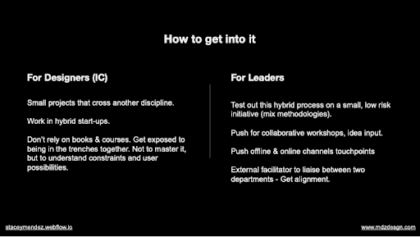
Women-centric design
Mansi Gupta, Founder of Unconform, opened up the important conversation of women-centric design – a crucial part of design discourse – because if we don’t talk about it, we can’t begin to imagine change.
Rachel shared: “It was really interesting to understand the levels of maturity when it comes to women-centric design, and all the more powerful that all of this was backed by research. I loved the examples that were presented, especially when so many of these were recognizable products and services that have always felt a little “off,” but in ways that are finally explainable. As a ethnic minority woman myself, I felt empowered by the tools that Mansi shared with us to talk about these ideas, and to challenge the status quo to start imagining what could be.”
The levels of women-centric design
Women-centric design has four levels: offensive, impartial, informed, and holistic (the dream, where we want to be!)
1. Offensive: these designs do not genuinely serve women, and expose surface level ideas that lack understanding. For example, colouring a product pink and shrinking normal-sized products to sell at a higher price, and glorifying “women’s empowerment”.
2. Impartial: these designs de-prioritise the divide in gendered responsibilities, viewing women as monolithic and ignoring intersectionality. For example, health AI responses that perpetuate biases about women’s bodies by basing answers on one specific type of woman. Have you ever wondered why voice controls like Alexa are always voiced by women as a default? How might this contribute to enforcing gender biases?
3. Informed: designs that still only just scratch the surface (i.e. women-only trains are still not accessible, menstrual leave is permitted in writing but no one feels safe to use it). “Femtech” is probably one you’ve heard of, problematic in that it tends to reduce reproduction to a “women’s thing” rather than something that concerns us all. Another example might be women’s services as “add-ons” (i.e. fitness apps with women-only features that are separately paid for).
4. Holistic: genuinely serving the needs of women by first understanding them, then having appropriate allocations to cope with pain points (and not charging them as “extra”). Great examples include:
-
-
- Tala, a product that allows access to “credit” via a new definition of credit score. Often, because of gendered responsibilities, women have a lower credit score and are thus barred from services that they should have equal access to.
- Callisto, a sexual harassment reporting app that helps users collect proof to build a case that can protect victims.
- Sehat Kahani, a service that connects displaced women and girls with at-home female doctors through telehealth technology.
-
Takeaways:
1. Design principles: some principles we can keep in mind when designing include safety (psychological and physical), trust (fix the system, not women themselves), non-linearity (accounting for biological differences in experiences), community (a role that builds resilience), and positive masculinity (actively creating and promoting a positive role for men).
2. Challenge the status quo: there’s still a long way to go… but we can start by shifting our mindsets from focusing on what exists already to imagining what could be.
3. Have the courage to ask: “What about women?”
What if people weren’t the product?
David Dylan Thomas, CEO of David Dylan Thomas, LLC, offered the chance for designers to self-reflect and collectively imagine what the community can do for the world. He reflected on the state of the web and what it’s become, revealing the extent of the harm that the attention economy has had in making us lose our humanity, as well as the evil that blinding chasing “engagement” has resulted in. He challenged us to do better. And this call to search deep within ourselves and do the right thing is exactly what we all need if we’re to craft a better, more virtuous and more just world.
Takeaways:
1. People have become the product
Over time, the web has become a mirror… social media, profiles, targeted marketing, our data-linked selves, all living in what we call the “attention economy”. We now see ourselves as a product in the same way that advertisers do.
2. F*** engagement
The natural engagement of human behaviour looks like the image below, where the closer we get to the line of prohibited content, the more enticing content becomes.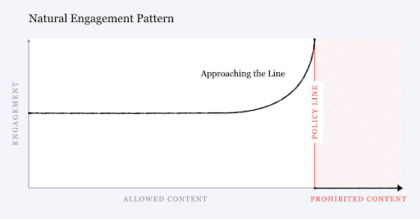
It’s a very toxic behaviour that we’re encouraging from each other and that tech leaders like Mark Zuckerberg are capitalising on.
The quest for engagement has killed people – think of the 2017 Rohingya crisis where over 10,000 Rohingya Muslims were killed, incited by the hate speech that Facebook helped promote without fact-checking and moderating.
3. Paradigm shifts
Take a look at indigenous communities systems of thinking. For example, the Blackfoot believe that wealth is not measured by money and property but by generosity. By that same definition, the “wealthiest” man in their eyes owns almost nothing because he has given it all away.
What if we reimagined a web that assumes everyone is good and worth helping? A web where engagement was measured by the number of people helped?
Thinking about the systems that our world is built upon is a dreadful realisation that everything is corrupt, but we can take steps to change it.
- Start by identifying your own values:
-
- Ask: am I getting closer to my values? What are the things I’d willingly leave money on the table for?
- What if the web reflected back to me the real me?
-
- Consider how your work brings you closer to or further away from these values:
-
- What are the things my company would be willing to leave money for?
-
- Co-imagine the future with the people hurt by the present:
-
- What if the web reflected back to me the people I can help?
-
Choosing empathy
As designers, we always come across the idea of “empathy” as an essential guideline to better understand the people who use our products and services. But, Imran Afzal, Principal Designer at Co-op Digital asked: “as we continue pushing onward in the name of “innovation,” are we forgetting what empathy is really about?” His talk questioned whether our relationship to empathy and how we put it in practice is becoming more fractured, more superficial.
If you’re a designer reading this and in need of reminding yourself why you got here and what we are collectively trying to do, sign up for one of Imran’s talks – he’s continuing to share these ideas outside of UX London.
A final word
Iman shared: “empathy is about finding echoes of another in yourself… empathy is a choice that leads to change”. A crucial reminder of what really matters when it comes to great design.

